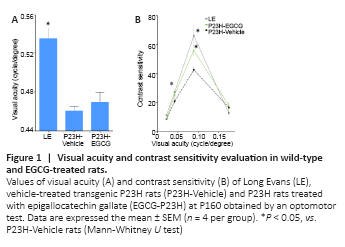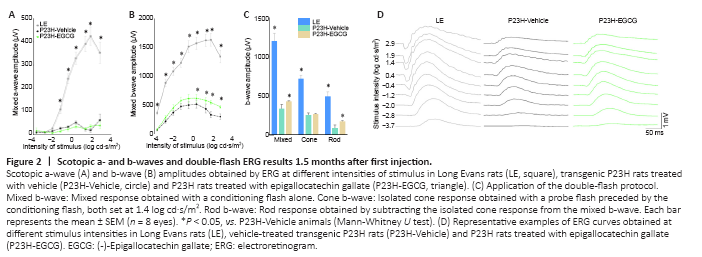视神经损伤
-
Figure 1|Visual acuity and contrast sensitivity evaluation in wild-type and EGCG-treated rats.

Visual parameters VA and CS of both eyes were assessed using an optomotor test. Our results showed a significantly lower VA in the P23H animals (0.461 cycles/degree) compared to the LE wild-type rats (0.535 cycle/degree) (Figure 1A). P23H animals treated with EGCG tended to preserve VA (0.470 cycle/degree) than the same untreated group with no statistically significant differences.
Similar results were observed in CS curves (Figure 1B) where the maximum frequency peak was obtained for a spatial frequency of 0.089 cycle/degree. CS values significantly decreased in the untreated P23H rats compared with the LE wild-type group (P = 0.009); however, EGCG treatment increased the CS values in P23H rats which received active treatment (EGCG) compared to those P23H rats which received normal saline instead (P = 0.008).
Figure 2|Scotopic a- and b-waves and double-flash ERG results 1.5 months after first injection.

P23H rats was 63 ± 26 μV. This value amounted to only 15% of the corresponding value in wild-type animals (424 ± 39 μV). EGCG treatment did not significantly modify the a-wave amplitude (Figure 2A). By contrast, the amplitude of the maximum b-wave in P23H rats treated with ECGC was significantly greater than that in P23H rats treated with vehicle (630 ± 67 μV vs. 528 ± 68 μV; Figure 2B). At the maximum stimulus (2.9 log cd·s/m2), the b-wave amplitude in the EGCG treatment group was 54% higher than that in the vehicle group (480 ± 23 μV vs. 312 ± 48 μV). The double-flash-isolated rod-driven response in P23H rats was lower than that in wild-type rats (80 ± 45 μV vs. 486 ± 65 μV), and the rod-driven contribution to mixed scotopic b-waves in P23H rats was lower than that in wild-type rats (24% vs. 41%; Figure 2C). The cone-driven response in P23H rats was also lower than that in wild-type rats (249 ± 32 μV vs. 712 ± 51 μV). The cone-driven contribution to mixed scotopic b-waves in P23H rats was higherthan that in wild-type rats (76% vs. 59%). EGCG treatment increased the rod-driven response compared with vehicle in P23H rats (163 ± 18 μV vs. 80 ± 45 μV), reaching a rod-driven contribution to mixed scotopic b-wave of 39% after EGCG treatment. Figure 2D shows an example of the scotopic response with increased intensities in LE, and P23H treated with vehicle or EGCG. Both a- and b-waves amplitude were higher in the treated rats than in the untreated rats and in EGCG-treated P23H rats, the amplitude of b-wave was at –2.8 log cd·s/m2.